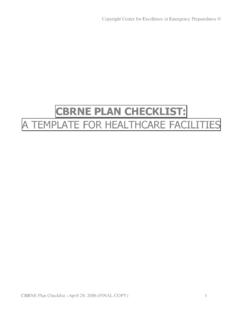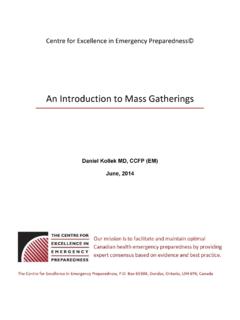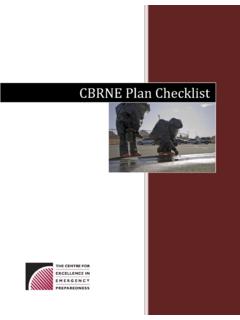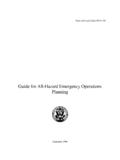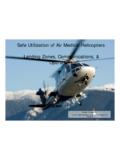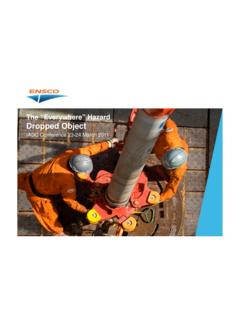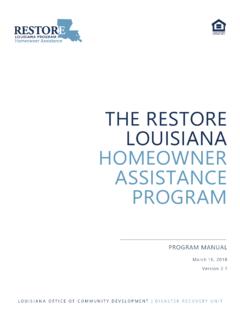Transcription of Hazard Risk Assessment Tool for Medical Facilities
1 I Hazard Risk Assessment tool for Medical Facilities ii Preface This is a sample Hazard Risk Assessment tool for Medical Facilities . Its purpose is to assist Medical Facilities in identifying hazards or vulnerabilities they must plan for. It is intended as a guide to assist in priority setting within the construct of a comprehensive emergency management program. The first step in any disaster plan is an Assessment of the local and regional risks. It is impossible to prepare for everything and limited resources make it important that the energy in preparing for an event be reflective of the likelihood of that event occurring. As such, the disaster Hazard risk Assessment tool becomes a critical document if our physicians should perform, refill and reassess periodically. iii Acknowledgements The Centre for Excellence in Emergency Preparedness wishes to acknowledge the following authors in helping to create this tool .
2 Brian Schwartz, , CCFP(EM), FCFP Associate Professor, Department of Family and Community Medicine, University of Toronto Bonnie Henry, , MPH, FACPM, FRCP(C) Director, Public Health Emergency Management Assistant Professor, Department of Health C are and Epidemiology UBC BC Centre for Disease Control 2009 Centre for Excellence in Emergency Preparedness Permission is granted to reproduce any part of this manual for educational or non-profit purposes. iv Table of Contents Preface .. ii Acknowledgements .. iii Risk, Probability and Impact .. 1 Medical Facility Hazard Risk Analysis tool Naturally Occurring Events .. 4 Medical Facility Hazard Risk Analysis tool Technological / Infrastructure Events (Internal/External) .. 5 Medical Facility Hazard Risk Analysis tool Human Related Events .. 6 Medical Facility Hazard Risk Analysis tool Events Involving Hazardous Materials.
3 7 1 Risk, Probability and Impact Risk is defined as the product of probability of the Hazard and its potential impact. Risk = Probability x Impact Probability may be expressed as the likelihood of an event occurring within a given time period; for example, the probability of event x occurring at a given location in the next year is y. Table 1 quantifies probability for a given event to assist in calculating risk. Issues to consider for probability include, but are not limited to: 1. known factors 2. historical data 3. statistics from industry, other geographical areas, etc. Table 1 Probability Rating Description Detail A Highly Likely nearly 100% probability in next year B Likely between 10 and 100% probability in next year, or at least one chance in 10 years C Possible between 1 and 10% probability in next year, or at least one chance in next 100 years D Unlikely less than 1% probability in next 100 years Impact For the purpose of this Hazard Assessment , the impact should be assessed along three aspects of how the Hazard being considered will affect the ability of the provider to deliver an appropriate level of service: the human impact, the property impact and the business impact.
4 The Overall Impact Rating then gives a picture of the effect on the Facility in the context of the healthcare and broader community. For example, the Hazard may directly impact the staff, clients or the infrastructure that is critical for service delivery. In addition the Hazard may result in illness or injury in the community and increased patient loads; if healthcare Facilities need to be evacuated, the entire healthcare system will be impacted. An event such as a labour disruption, or a power failure may directly limit a provider s ability to deliver services while not directly impacting the rest of the region. Most events will impact both the facility and the community or region to varying degrees. The overall impact rating evaluates the potential Hazard 's impacts on the ability of the facility to deliver services. The rating given for human impact should consider whether the Hazard has/is: 1.
5 Unlikely to cause injury, illness or death in staff or patients 2. low probability of injury, illness or death in staff or patients 3. high probability of injury or illness in staff or patients; low probability of death 4. high probability of death in staff or patients 2 The rating given for property impact should consider whether the Hazard is/will cause: 1. unlikely to cause physical plant or equipment damage requiring any replacement costs or recovery time 2. minor physical plant or equipment damage requiring some replacement costs or recovery time 3. moderate physical plant or equipment damage requiring moderate replacement costs or recovery time 4. extensive physical plant or equipment damage with high replacement costs and recovery time The rating given for business impact should consider whether the Hazard is/will cause: 1. unlikely to cause service interruption12. minor or limited service interruption or damage to public image or damage to public image of the institution 3.
6 Significant/widespread service interruption 4. unable to provide services 1 Service interruption may include: employees unable to work, staff unable to access or leave facility, interruption of supplies, lack of financial reserves/cash flow, imposition of fines, penalties or other legal measures 3 Table 2 The Overall Impact Rating is the sum of the three impact factors for each Hazard : 4 Marginal Normal level of functioning or increased level of service required 5-7 Serious Facility can provide a normal level of service with assistance from within region or within local community; or, facility can provide a reduced level of service with normal resources 8-10 Critical Facility can provide a normal level of services with assistance from outside the local community or region; or, facility can provide a minimal level of service with normal resources 11-12 Catastrophic Facility cannot provide services without extensive assistance from provincial or federal resources Combining the Impact Rating with the Probability Rating determines the Risk, as outlined in Table 3.
7 Table 3: Risk Rating 2 A Highly Likely B Likely C Possible D Unlikely 11-12: Catastrophic A11-A12 B11-B12 C11-C12 D11-D12 8 -10: Critical A8-A10 B8-B10 C8-C10 D8-D10 5 7: Serious A5-A7 B5-B7 C5-C7 D5-D7 4: Marginal A4 B4 C4 D4 High Moderate Low Very Low Using Table 3, planning may proceed with those events prioritized at the highest risk. 2 Adapted from: All- Hazard Assessment Model Version 3, Manitoba Health Disaster Management Services, June 2004. Impact Rating Probability Rating 4 Medical Facility Hazard Risk Analysis tool Naturally Occurring Events Event Probability Human Impact Property Impact Business Impact Overall Impact Rating Risk Rating A, B, C, or D (Table 1) 1, 2, 3, or 4 1, 2, 3, or 4 1, 2, 3, or 4 4-12 (Table 2) (Table 3) Hurricane Severe thunderstorm Tornado Blizzard Extreme Heat Extreme Cold Ice Storm Earthquake Tidal Wave Drought Fire - External Flood External Landslide Volcano Epidemic (Pandemic) 5 Medical Facility Hazard Risk Analysis tool Technological / Infrastructure Events (Internal/External) Event Probability Human Impact Property Impact Business Impact Overall Impact Rating Risk Rating A, B, C, or D (Table 1)
8 1, 2, 3, or 4 1, 2, 3, or 4 1, 2, 3, or 4 4-12 (Table 2) (Table 3) Electrical Failure Generator Failure Transportation Emergency Fuel Shortage Water Emergency Sewer Failure Fire Alarm Failure Communications Failure Medical Gas Failure Medical Vacuum Failure HVAC Failure Information Systems Failure Fire - Internal Flood - Internal Supply Shortage Structural Damage HAZMAT Exposure - Internal 6 Medical Facility Hazard Risk Analysis tool Human Related Events Event Probability Human Impact Property Impact Business Impact Overall Impact Rating Risk Rating A, B, C, or D (Table 1) 1, 2, 3, or 4 1, 2, 3, or 4 1, 2, 3, or 4 4-12 (Table 2) (Table 3) Mass Casualty Incident (Trauma) Mass Casualty Incident (Infectious) Terrorism - Biological VIP Situation Infant Abduction Hostage Situation Civil Disturbance Labour Action Forensic Admission Bomb Threat 7 Medical Facility Hazard Risk Analysis tool Events Involving Hazardous Materials Event Probability Human Impact Property Impact Business Impact Overall Impact Rating Risk Rating A, B, C, or D (Table 1) 1, 2, 3, or 4 1, 2, 3, or 4 1, 2, 3, or 4 4-12 (Table 2) (Table 3) Mass Casualty HAZMAT Incident Small Casualty HAZMAT Incident Chemical Exposure - External Small Medium sized Internal Spill Large Internal Spill Terrorism - Chemical Radiological Exposure - Internal Radiological Exposure - External Terrorism - Radiologic 8 Source documents: 1.
9 Kaiser Permanente Medical Center Hazard and Vulnerability Analysis 2. All- Hazard Assessment Model Manitoba Health Disaster Management 3. Integrated Hospital Emergency Management System OCIPEP, 2001 4. CBRNE Plan checklist A Template for Healthcare Facilities - 2002

